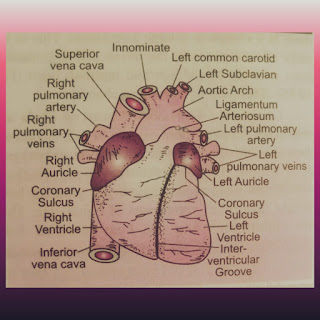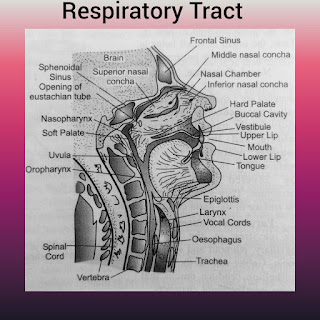The Human Heart? Structure, Working, Heart beat, Heart rate, Heart Sound and Cardiovascular diseases.
Human heart is the hollow muscular organ of the body which pump and supply the blood throughout the circulatory system. It is located a little to the left of the middle of chest. Heart is very sensitive organ and more responsible for life, so it covered with the rib cage to protect any injury. The weight of heart is about 240 grams and the size of heart is about a fist.
Structure- The structure of heart is divided into two parts- Exterior structure and Interior structure.
1) Exterior structure- Heart is made up of three layers of tissue- Pericardium, Myocardium and Endocardium.
i) Pericardium- is the outer layer of heart. It is made up of two layers Outer parietal pericardium and inner visceral pericardium. Between these layer their are potential space called pericardial cavity. This Pericardial cavity contain up to 50ml of pericardial fluid. This fluid keeps the heart moist and reduce the friction between heart wall and surrounding tissue, when the heart beats.
ii) Myocardium- is a middle layer of heart, formed by cardiac muscle fibers. This layer is responsible for heart pumping action because bulk of heart is made up by myocardium.
iii) Endocardium- This is the innermost layer of heart, formed by endothelial cells. It ensures that the flow of blood should be smooth.
2) Interior Structure - Human heart is divided into four chambers. Two ventricles and two Atrium. Left and right chambers are divided by fibrous septum. Heart have four valves to control the backflow of blood-
i) Tricuspid valve- lies between the right atrium and the right ventricle to control the flow of blood from right atrium to right ventricle.
ii) Pulmonic valve- located between the right ventricle and the pulmonary artery to control the flow of blood from right ventricle to the lungs.
iii) Mitral valve- lies between the left atrium and left ventricle to control the flow of blood from left atrium to left ventricle.
iv) Aortic Valve- lies between the left ventricle and the aorta to control the flow of blood from left ventricle to the body.
Working- The function of heart is to pump the blood throughout the body. Overall daily heart pumps 7,000 liters of blood. The one sided two chambers carry deoxygenated blood and the other sided two chambers carries oxygenated blood.
Deoxygenated Blood enter inside the right atrium by superior vena cava and inferior vena cava. Superior vena cava carry the blood from upper part of body and the inferior vena cava carry the blood from lowest part of body. From the Right atrium, blood pass into the right ventricle by opening of tricuspid valve. From the right ventricle chamber pulmonary valve open and blood pass into the lungs by left and right pulmonary artery. Inside the lungs, deoxygenated blood convert into oxygenated blood by exchange the gases.
From the Lungs, Oxygenated blood enter inside the heart through right and left pulmonary veins. These veins open into left atrium. Left atrium blood is pass into left ventricle through the opening of mitral valve. Then the blood is move into the aorta through the opening of aortic valve. From the aorta oxygenated blood pass throughout the whole body system.
Heart Beat- The spontaneous and rhythmic contraction and relaxation of the heart to pump out and receive the blood from body is called heart beat. The heart contract more than 2.5 billions times in a life time.
Heart rate- The times of heart beat per minute is called heart rate. It is about 72 times per minutes in adults.
Heart sound- Heart is sound like Lub and Dup.
i) Lub sound is low pitched and not very loud. It is for long duration about 0.15 seconds. It is produce while ventricle contraction.
ii) Dup sound is higher pitched and louder. It is for short duration about 0.1 seconds. It is produce while ventricular relaxation.
Cardiovascular Diseases- There are number of cardiovascular diseases that affect the blood vessels and the heart. Heart is the sensitive organ of body, if it suffer with any disease, it may lead death. It includes Arteriosclerosis, Atherosclerosis, Hypertension, Heart attack and stroke.
i) Arteriosclerosis- is the deposition of fibrous tissue in the artery. Continues deposition cause rigid and hardening the wall of artery. So that artery loose their elasticity and it may lead the unwanted rupture. During the rupture of artery, blood start making clot and this clot block the flow of blood. This type of clots leads the death or heart attack.
ii) Atherosclerosis- is the condition in which fat molecules and cholesterol start deposit in artery. The continues deposition leads the narrowing the space of lumen. It leads to the high blood pressure because of blood is not able to flow properly. When the lumen is completely covered with these deposition, it cause heart attack.
iii) Hypertension- is a condition when blood pressure is rise too high than their normal range. In this the force of blood against the artery walls is too high. High blood pressure is a silent killer. It damage the arteries in kidney, eye, brain which leads chronic nephritis, blindness and stroke.
iv) Heart attack- is the condition in which the arteries are blocked due to formation of clot, which stop the blood flow to the other heart cells. The cells are die due to lack of oxygen and glucose cause heart attack.
v) Stroke- The required amount of blood is not supply to the brain because of some clot formation or high blood pressure in arteries which lead damage of brain called stroke. Overall due to lack of blood supply, the brain did not get enough oxygen and glucose for their functioning. In this condition, the patient loses some vital activity.

.jpeg)




Comments
Post a Comment